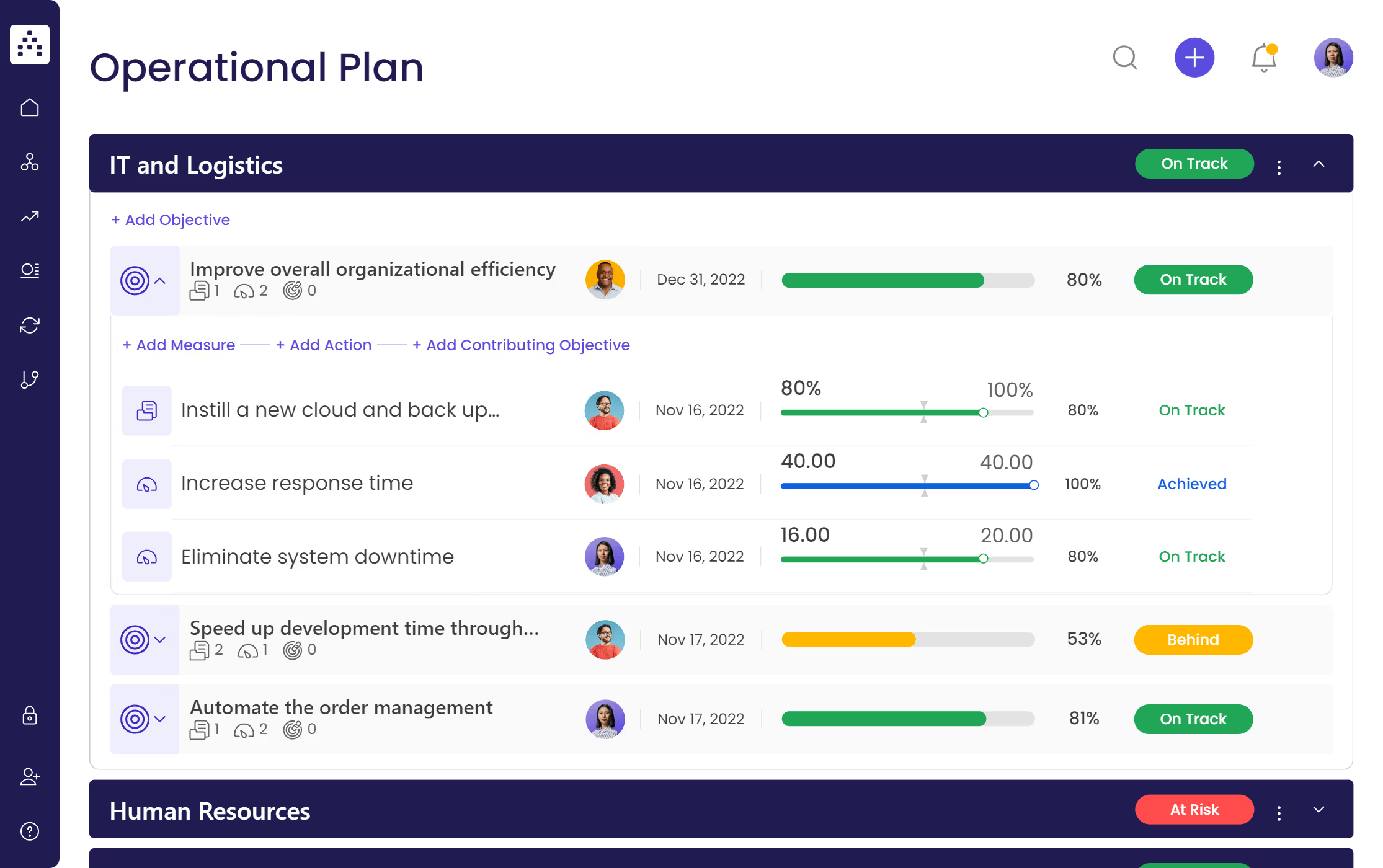Do you even need one? Perhaps your organization excels at executing business strategies, keeping everything on track while you monitor performance in real-time.
That's the hope, isn't it?
But let's be honest. You wouldn't be here reading this article if you were confident in your existing annual operating planning process.
So let’s dive in and explore the step-by-step process to create your annual operating plan. This guide also includes a free planning template that will help you flesh out the plan’s details.
What Is An Annual Operating Plan?
An annual operating plan (AOP) is a forward-looking blueprint that translates your business strategy into actionable steps. It’s a detailed roadmap that outlines your organization's strategic objectives, annual budget, detailed action plans, and resource allocation for a specific fiscal year.
%20(1).avif)
With an AOP (also known as the annual business plan), you get a 10,000-foot view of how to allocate project resources and what risks to manage so you can execute key priorities. The plan serves as a bridge between high-level business goals and day-to-day operations.
💡What is the difference between a business strategy and an annual operating plan (AOP)? Business strategy outlines the choices you need to make for your organization to win. AOP involves budget allocation, timelines, and deliverables, empowering your team to execute your strategy successfully.
Benefits Of An Annual Operating Plan
Organizations can realize the full benefits of an annual operating plan when it's tightly integrated with their strategic plan and financial budget. Here’s how:
Maximized resource efficiency and utilization
An AOP ensures efficient resource allocation to projects and initiatives that align with the business strategy and financial budget. It helps you direct human, financial, and other assets toward achieving strategic objectives, minimizing resource waste by linking daily operations with long-term goals.
Alignment and focus on key business priorities
An annual operating plan provides a clear roadmap toward a shared vision and helps everyone in your team understand their roles in meeting business objectives. It promotes collaboration and communication while eliminating silos, fostering a unified, goal-driven work environment.
Controlled strategy execution
By defining specific Key Performance Indicators (KPIs) and milestones in your AOP, you can easily assess whether the company is on track to achieve its goals. These metrics will help you identify areas that require immediate course correction to stay aligned with the overall strategy.
Confident, data-driven decisions
A well-rounded AOP provides you with data to help you make the right decisions. These insights empower proactive responses to opportunities and challenges, ensuring that all team actions are focused on outcomes.
How To Create An Annual Operating Plan?
Here’s a step-by-step guide for you to follow:
Step 1: Do the initial research and analysis
To kick off the planning process, assess the current state of your organization. Review the previous year's performance, considering various data sources, including financial statements and operational reports.
By doing a thorough business review, you ensure that your annual operating plan for next year is grounded in reality.
This helps you create a holistic plan that considers your business’s needs, strengths, and weaknesses. It also sets the stage for subsequent operational and financial planning—more on this later in the article.
👉How Cascade helps you:
With Cascade’s extensive library of 1,000+ integrations, you can centralize all your business data in one place. This simplifies data analysis and gives you easy access to past performance for an objective and thorough review.
Step 2: Consult with key stakeholders to understand the needs
The effectiveness of your annual operating plan (AOP) hinges on its alignment with your overarching company goals. Without it, you’re just creating a set of plans that, when executed, will have little to no impact on the overall business strategy.
To ensure organizational alignment, discuss with the CEO and CFO about key business priorities. Also, meet with other key stakeholders like department heads to gather insights on departmental needs and priorities.
Their input will help you set realistic and achievable objectives and also get them fully onboard when the time comes to put the plan in motion.
👉How Cascade helps you:
Cascade’s Metrics Library helps you tie metrics with your business objectives so you can have total visibility of what’s happening across the organization and achieve data-driven organizational alignment from top to bottom.
Step 3: Set a budget and allocate resources
First, look at your revenue goals and identify how much will you actually need to sell to hit your targets.
Collaborate with department heads to assess the availability of manpower, equipment, and other resources. Verify whether these are sufficient to meet your set targets.
List out expenses, covering everything from materials and labor to marketing and new equipment. This exercise provides a clear picture of how much of resources you’ll need to allocate across various projects and functions to fulfill the objectives of your annual plan.
👉How Cascade helps you:
Cascade makes budget tracking possible with custom fields that can capture data and link them to objectives. The budget custom field is a numerical field type where you can set the allocated, forecast, and spent values. As you work on your plan, you can update the relevant values and see a progress bar of the allocation vs. actuals.
📹 Check out this short video and learn how to set your custom field for budget tracking:
Step 4: Prepare a plan
In this step, you should define your metrics and go beyond mere measurement. Set concrete targets. Then, link these targets to initiatives, projects, and actions that will drive you toward those numbers.
Whether your organization operates with multiple departmental plans or a single, unified annual operating plan, ensure each department head outlines key projects and action plans aimed at achieving their annual targets.
When setting your KPIs to track progress, don’t forget to focus on both leading and lagging indicators.
👉How Cascade helps you:
Cascade’s free operational plan template gives you a clear and simple plan structure that you can use to easily collaborate with other department heads or team leaders. It’s pre-filled with examples and fully customizable to fit your needs.
📚 Are you an organization with multiple business units, each requiring its own AOP aligned with a central strategic plan? Explore our case study to see how a customer uses Cascade for strategic alignment between AOPs of different business units and the organization’s overarching 3-year strategy.
Step 5: Review and approve
Ensure your AOP is well-rounded and considers the needs of different stakeholders. Have different departments review the plan to promote alignment and collaboration. This step also ensures everyone is on the same page from the start.
After an internal review, secure approval from decision-makers, such as board members or executives, to gain buy-in at the highest levels. This buy-in makes it easier to implement your annual plan.
Step 6: Execute and monitor
Everyone involved must start working on their assigned initiatives. Ensure every team member knows that their duties are time-bound and remains accountable for completing them.
To make sure you're staying on course, it's vital to keep an eye on the progress through the KPIs established earlier. Monitoring progress against objectives ensures that you stay on track throughout the year.
💡Tip: Set a regular schedule to review your annual operating plan. Depending on your needs, this could be weekly, monthly, quarterly, or semi-annually.
👉How Cascade helps you:
Cascade can help with monitoring through its user-friendly dashboards and comprehensive reporting capabilities.
Dashboards use chart widgets and graphs populated with real-time data so you can understand what’s happening in different time frames.
.jpg)
Cascade’s reports empower decision-making by providing the context of the data presented.
.png)
Annual Operating Plan Example With A Free Template

Cascade’s Operational Strategy Template is suitable for organizations of all sizes, and you can use it for free.
This template comes with pre-filled fields to guide you on where to enter your data so you can quickly set it up within minutes. You can choose your focus areas and write down the objectives. Then you can set the KPIs that will be measured and tracked as you progress with the plan.
Once set, designate responsible team members and use Cascade's real-time dashboard for monitoring.
It’s a tried and tested template that aligns your employees with the business strategy and provides clear guidelines on how to execute it.
Execute Your Annual Operating Plan With Cascade 🚀
You can’t simply make an AOP without tying it to the larger picture. Executing a plan without clear alignment to the overall business strategy is futile. Yes, your company is busy, but you’re getting nowhere.
With Cascade, you can centralize your strategy. By doing so, you can easily see how the execution aligns with your business strategy.
With its dynamic dashboards, real-time reports, and various other features, you can create seamless plans, execute them, and not worry that they’re being completed in silos. Every action your teams take, and every small goal they achieve, is connected to a bigger strategy that helps achieve your organization’s long-term vision.
Want to give it a try? Sign up today for free or book a 1:1 product tour with one of Cascade’s strategy experts.
Annual Operating Plan FAQ
What should be included in an annual operating plan?
A well-structured annual operating plan should include:
- A clear set of strategic objectives
- Detailed action plans
- Performance metrics
- Resource allocation
- Risk mitigation plans
What is the difference between annual operating plans and budgets?
Annual operating plans and budgets are both financial planning tools used to manage performance. An AOP is a comprehensive blueprint that includes your overarching goals and the details to execute them, including the financial and human resources needed.
On the other hand, CFOs use budgets to focus mostly on the financial aspect of the organization’s plan and are highly numbers-driven. They provide detailed projections of revenue, expenses, and cash flows but lack the strategic depth of AOPs. Unlike AOPs, they’re also less flexible once approved and are primarily intended for financial and accounting teams.






.png)
.jpg)
.jpg)
%20(1)%20(1)%20(1)%20(1)%20(1).png)



